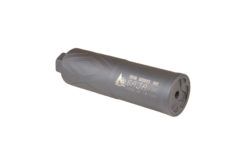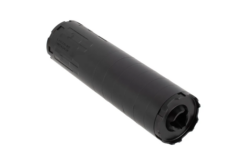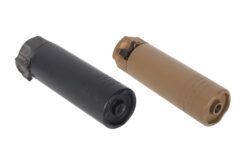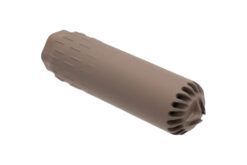NFA, Suppressors
Buying Your First Rifle Suppressor: A Complete Guide
Table of contents
Purchasing your first rifle suppressor is an exciting step toward transforming your shooting experience, whether you’re at the range, hunting, or enjoying time in the field. At AR15Discounts.com, we’re dedicated to guiding you through every aspect of choosing and acquiring a suppressor, ensuring you understand its benefits, legal requirements, and practical expectations. This page is tailored for first-time buyers in states where suppressors are legal, with a focus on rifle suppressors for platforms like the AR-15, particularly when shooting 5.56 or .300 Blackout. We’ll explore why a dedicated 5.56 can might offer the quietest performance for a 5.56 rifle, while a 30-caliber suppressor provides greater versatility for future use, and we’ll set realistic expectations for sound reduction, emphasizing the role of subsonic ammunition for achieving a quieter rifle with .300 Blackout. Let’s dive in to help you make an informed decision for your first suppressor purchase.
What Does a Suppressor Do?
A suppressor is a device that attaches to your rifle’s muzzle to reduce the noise and flash produced when firing. Contrary to Hollywood portrayals, they don’t make a rifle silent; they lower the gunshot’s intensity to safer, more comfortable levels, protecting your hearing and enhancing your overall experience. For first-time users, the difference is remarkable—shooting feels smoother, less disruptive, and more enjoyable, allowing you to concentrate on precision and technique. Suppressors also reduce recoil, enabling faster follow-up shots, stabilize the barrel for improved accuracy, and minimize muzzle flash, which is particularly useful in low-light conditions like dusk hunting. Additionally, they reduce noise pollution, making them considerate for range neighbors or wildlife-rich environments.The terms “suppressor” and “silencer” are often used interchangeably, but “suppressor” is more accurate, as it reduces, rather than eliminates, sound. “Silencer” was a marketing term coined by inventor Hiram Maxim, yet both refer to the same device. Regulated under the National Firearms Act (NFA), suppressors are a valuable addition for rifle owners in permitted states. Our suppressor collection at AR15Discounts.com offers a variety of models to suit your first purchase.

Realistic Expectations
When buying your first can, understanding what it can realistically achieve is crucial, especially for rifles like the AR-15 shooting 5.56 or .300 Blackout. A suppressor significantly reduces the muzzle blast—the loud explosion from escaping gases—but it cannot eliminate all sound. For 5.56 rifles, which typically use supersonic ammunition, the bullet’s sonic crack, caused by breaking the sound barrier, remains audible even with a suppressor. A dedicated 5.56 can, designed specifically for 5.56 NATO or .223 Remington, provides the best sound reduction for this caliber, typically lowering noise to around 130 to 140 decibels. This level is safer for hearing but still requires ear protection for extended shooting sessions to prevent long-term damage. These suppressors are often lighter and more compact, improving maneuverability on 5.56 AR-15s, particularly for short-barreled rifles used in tactical or home defense scenarios.
For shooters aiming for a significantly quieter rifle, subsonic ammunition is essential, particularly with .300 Blackout. Subsonic rounds travel slower than the speed of sound, eliminating the sonic crack, resulting in a much quieter shot—often in the range of 120 to 130 decibels with a high-quality suppressor. This level can sometimes allow shooting without ear protection for brief moments, such as a single hunting shot, though hearing protection is still recommended for safety during prolonged range use.
The .300 Blackout was designed with suppression in mind, making it a favorite for hunters seeking minimal noise to avoid startling game or disturbing the environment. For example, subsonic .300 Blackout is ideal for close-range hunting within 100 to 150 yards, where its lower velocity and energy compared to supersonic rounds are less impactful. However, for longer ranges or precision shooting, supersonic .300 Blackout or 5.56 may be preferred, though the sonic crack will make shots noticeably louder.A 30-caliber (7.62mm) suppressor, compatible with 5.56, .300 Blackout, and .308, offers greater versatility but may not suppress 5.56 as effectively as a dedicated 5.56 suppressor, resulting in slightly louder shots, perhaps 3 to 5 decibels more.
The trade-off is often worthwhile for first-time buyers who value flexibility. If you later acquire a .300 Blackout for quiet hunting or a .308 for long-range shooting, a 30-caliber can adapts seamlessly, eliminating the need for additional purchases and paperwork. With subsonic .300 Blackout, a 30-caliber suppressor can deliver near-silent shots, ideal for hunting, while still providing solid sound reduction for 5.56 or .308, even with supersonic ammo.
Beyond sound, cans reduce recoil by approximately 20 to 30 percent, improving control and follow-up shot speed. They also minimize muzzle flash, crucial for night shooting or hunting with night vision, ensuring better visibility. Maintenance needs vary—many sealed suppressors can go thousands of rounds without cleaning, making them low-maintenance for casual shooters, while user-serviceable models allow periodic cleaning for those who shoot frequently or use high-fouling ammunition. Weight and length impact handling; lighter, shorter suppressors enhance portability but may offer slightly less sound reduction. Your first suppressor should balance these factors with your shooting goals, whether prioritizing maximum quietness with a 5.56 suppressor or versatility with a 30-caliber model.
The Importance of Customer Service
When purchasing your first can, selecting a company with excellent customer service is critical, particularly in the rare event of a baffle strike. A baffle strike occurs when a bullet contacts the suppressor’s internal baffles, often due to improper alignment between the can and firearm or a mismatched setup, such as using an incompatible caliber. This can damage the suppressor, requiring repair or replacement, which can be costly and time-consuming. A reputable company with responsive customer service ensures quick resolution, whether the issue arises from a manufacturing defect or user error, such as incorrect mounting. Choosing a brand with a strong track record for addressing baffle strikes provides peace of mind, protecting your investment and minimizing downtime. At AR15Discounts.com, we partner with top brands known for their reliability and support, ensuring your first purchase is backed by exceptional service.

Legal Considerations for Ownership
Before buying, confirm its legality in your state. Federally, suppressors are regulated by the NFA, requiring ATF approval and a $200 tax stamp per suppressor. They are legal for civilian ownership in 42 states, but prohibited in California, Delaware, Hawaii, Illinois, Massachusetts, New Jersey, New York, and Rhode Island. In permitted states, verify local regulations, as some restrict suppressor use for activities like hunting. AR15Discounts.com supports shooters in legal states, and we encourage checking your state’s laws to ensure compliance. A Suppressor State Legality Map may be added in the future to simplify this process.
How to Purchase Your First Suppressor
Acquiring your first can involves a clear process under NFA regulations. Here’s how to buy one from AR15Discounts.com in a legal state:
1. Select Your Suppressor
Choose a can that aligns with your rifle and shooting goals. For rifles, options include rimfire suppressors for .22 LR, ideal for low-cost shooting or small-game hunting; centerfire suppressors for larger calibers like 5.56 or .308, suited for tactical or hunting rifles; or multi-caliber suppressors, such as 30-caliber models, for flexibility across 5.56, .300 Blackout, and .308. Evaluate weight, length, sound reduction, and barrel threading compatibility. Our suppressor collection offers options for your first purchase.
2. Find an SOT Dealer
Suppressors must be transferred through a licensed dealer with a Special Occupational Tax (SOT) status, who holds the suppressor until ATF approval. AR15Discounts.com coordinates with your chosen SOT dealer for a smooth transfer. In states like California where they are banned, sales are prohibited, so confirm your state’s laws.
3. Submit ATF Form 4 with Photos and Fingerprints
The ATF Form 4 requires your personal information, suppressor details, and dealer information, plus two passport-style photos, available from pharmacies or ATF kiosks, and fingerprint cards, obtainable from local police or third-party services. File electronically via the ATF’s eForm system for faster processing or use a paper form. Your dealer can assist to ensure accuracy.
4. Pay the $200 Tax Stamp
A one-time $200 tax stamp per can is required by the ATF, paid during Form 4 submission. Multiple suppressors need separate stamps. Your dealer will guide this process.
5. Await ATF Approval
ATF approval takes 90 to 120 days for eForm 4 submissions or six to nine months for paper forms. Track eForm progress via the ATF’s eForm portal. AR15Discounts.com ensures prompt shipping to your dealer.
6. Pick Up Your Suppressor
Once approved, your dealer notifies you to pick up your suppressor, complete final paperwork, and take it home.
Understanding Suppressor Trusts
A trust is a legal entity allowing multiple people, such as family or friends, to share access to a suppressor without additional tax stamps. It’s ideal for shared use or estate planning, simplifying ownership transfers. Setting up a trust requires an attorney specializing in NFA items. AR15Discounts.com can connect you with resources to explore this option.
Why Choose AR15Discounts.com?
At AR15Discounts.com, we’re the builder’s choice for AR-15 parts, kits, accessories, and suppressors, offering unmatched value and service. Benefits include competitive pricing for budget-friendly, high-quality suppressors; a diverse suppressor catalog with rimfire, centerfire, and multi-caliber models; fast shipping to your SOT dealer; and expert support to guide you from selection to ATF paperwork. Pair your suppressor with our muzzle devices for a complete setup.
Yes, it is legal to own a rifle suppressor in 42 U.S. states, provided you follow the federal process under the National Firearms Act (NFA), which includes passing a background check, submitting ATF paperwork, and paying a $200 tax stamp. Always check your state laws before purchasing.
Yes. Every suppressor purchase requires a $200 tax stamp issued by the ATF. This is a one-time fee and part of the registration process under the NFA.
Approval times vary. Paper submissions can take 8–12 months, while eForms are often processed in 3–6 months. Processing times can fluctuate depending on the volume of ATF and the accuracy of the paperwork.
Direct-thread suppressors screw directly onto the barrel and are ideal for rifles or fixed-barrel pistols. Boosters, also known as Nielsen devices, are required for most semi-automatic pistols to help cycle the action by temporarily decoupling the suppressor during recoil.
Yes, many suppressors are designed to be used on multiple firearms, as long as the thread pitch and caliber are compatible. Swapping pistons or mounts may be necessary for proper fit and function.
Suppressors can slightly increase velocity and often improve accuracy by reducing recoil and muzzle rise. However, improper alignment can negatively impact performance.
.22LR and 9mm are two of the most popular and beginner-friendly calibers. They offer excellent noise suppression, affordable ammo, and broad compatibility with popular firearms.
No. While suppressors significantly reduce noise, they don’t make firearms completely silent. The term “silencer” is misleading—there’s still a noticeable sound, especially with supersonic ammunition.
No, but subsonic ammo helps reduce noise even further by eliminating the sonic crack. It’s especially beneficial in .300 Blackout, 9mm, and .22 LR setups where quiet performance is a priority.
We’d look for a company with a great warranty and customer service. Lots of companies are doing great work, but if pressed our personal experience is Rugged and their Rugged Razor cannot be beat.





